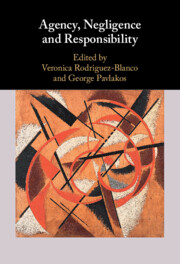Book contents
- Agency, Negligence and Responsibility
- Agency, Negligence and Responsibility
- Copyright page
- Dedication
- Contents
- Figures
- Contributors
- Acknowledgements
- Introduction
- Part I Will and Blameworthiness
- Part II Agency, Reasons and Inadvertence
- Chapter 5 The Possibility of Pure Negligence
- Chapter 6 Agent-Relativity without Control
- Chapter 7 The Boundaries of Negligence
- Chapter 8 The Backward-Looking Puzzle of Responsibility in Negligence
- Chapter 9 Responsibility and Agency
- Part III The Significance of Action in Negligence
- Bibliography
- Index
Chapter 8 - The Backward-Looking Puzzle of Responsibility in Negligence
Some Preliminary Thoughts for Understanding Inadvertent Actions
from Part II - Agency, Reasons and Inadvertence
Published online by Cambridge University Press: 28 October 2021
- Agency, Negligence and Responsibility
- Agency, Negligence and Responsibility
- Copyright page
- Dedication
- Contents
- Figures
- Contributors
- Acknowledgements
- Introduction
- Part I Will and Blameworthiness
- Part II Agency, Reasons and Inadvertence
- Chapter 5 The Possibility of Pure Negligence
- Chapter 6 Agent-Relativity without Control
- Chapter 7 The Boundaries of Negligence
- Chapter 8 The Backward-Looking Puzzle of Responsibility in Negligence
- Chapter 9 Responsibility and Agency
- Part III The Significance of Action in Negligence
- Bibliography
- Index
Summary
Inadvertent actions in relation to legal and moral responsibility have been represented as puzzling on many occasions. In this chapter, I aim to show they are puzzling for different reasons than those usually proposed. Before I do this it is important to clarify some assumptions and presuppositions. First, the chapter presupposes that intentional action constitutes the paradigm of action . Second, it presupposes that intention and intentional actions run parallel to practical reason, and that the first-person perspective is the primary perspective to explain intentional action. Inadvertent actions seem to be an important challenge to this conception and this study aims to pave the way for thinking about negligence in the context of the first-person perspective. The aim of the chapter is modest in the sense that it neither offers an account of negligence, nor a criticism of the views that have been advanced in the literature, but identifies a puzzle that arises in the context of actions from the first-person perspective and gestures towards a possible methodology for thinking about negligent actions. I see this as a necessary and preliminary task before engaging with the nature of negligent acts and responsibility for negligence.
Keywords
- Type
- Chapter
- Information
- Agency, Negligence and Responsibility , pp. 154 - 166Publisher: Cambridge University PressPrint publication year: 2021

